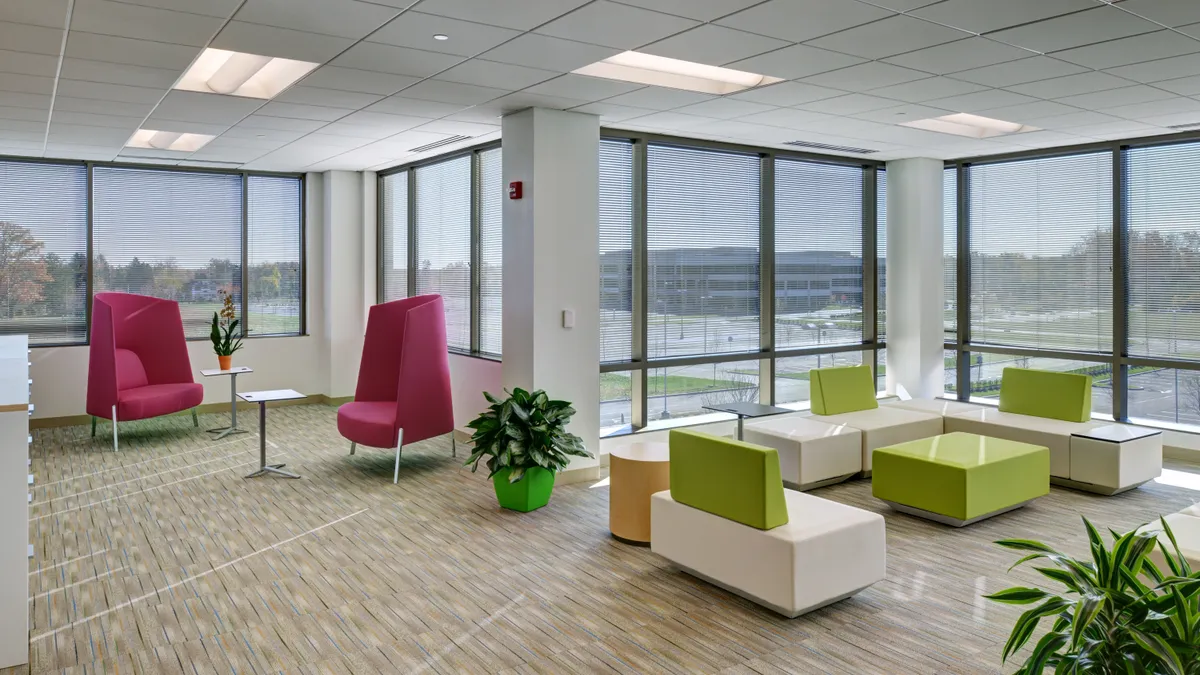Offices have come a long way from bare-bones cubicles and indoor-outdoor carpet. Today’s designers are already thinking beyond the 21st century, incorporating nontraditional elements into layout and design that are revolutionizing workplace wellness and technological integration — all with an eye toward flexibility.
Employers want workers to be safe, healthy, comfortable and happy. These attributes make for a productive workforce that office designers are helping to create. The workplace is transitioning away from the “cubical farm” model in favor of a new environment that brings out positive emotions, enables new work styles, increases collaboration and promotes productivity, Colin Finley, VP of client solutions at Chicago-based Ideation Studio, a multidisciplinary design firm, told HR Dive.
Maura Nevel Thomas, a speaker, trainer and author, says that maintaining employees’ productivity in the workspace starts with design. Thomas, who has also talked about improving workplace productivity as a TEDx presenter, says that designing a 21st century workspace requires careful planning of many components, including a floor plan that maximizes productivity.
Both Finley and Thomas agree that the shift in office design towards open spaces can encourage collaboration, but that quiet workspaces are necessary for knowledge workers and creative people to be productive.
Branding
Companies have always leaned toward a particular office style, usually early contemporary, but none that stood out as a reflection of their mission or culture.
Branding is becoming more important to companies as a way of communicating the uniqueness of their culture, says Finley, and office design is evolving to mirror corporate brands and culture.
"The desk will never go away, but the desire for a change of scenery in the office is definitely on the rise.”

Colin Finley
VP of Client Solutions, Ideation Studio
Companies and self-employed individuals who need workspace but don’t want the high cost of ownership or the hassle of finding real estate can turn to firms like Knotel for help. Co-founded by CEO Amol Sarva, Knotel sets up workspaces for its clients, even offering month-to-month options. It recently set up the headquarters of TechStars, a startup accelerator, in one of its Manhattan locations. Knotel calls the office space a “culture-coded” environment.
TechStars’ name alone conjures up visions of a futuristic setting, and the layout, design and colors don’t disappoint. Among the highlights:
- columns separate workspaces, which include communal areas, as well as private nooks for solo workers;
- large windows to let in natural light;
- seating includes large, upholstered living-room like chairs and sectionals;
- long tables accommodate team projects and meetings; and
- bookcases create library spaces.
Flexible workspace
Just as more employees want flexibility in their work lives, cutting-edge workspaces also are becoming more flexible.
In a June interview with Construction Dive, Ashley Servis, senior designer at Joshua Zinder Architecture + Design, said that employers who are attracting the best talent recognize that not all employees have the same work style, so they need to invest in creating workspaces that offer flexibility.
Servis said that flexibility allows employees to work in ways that they’re most comfortable. That might include standing up, curling up in a soft, home-like chair or sitting at a desk. Servis added that the most satisfied workers are the ones employers can retain.
Layout, design, color and lighting can have a big impact on satisfaction and productivity, so, designers are also working with employers on offering flexible work areas. Finley says a flexible workplace allows companies to offer both accommodations for solo workers and spaces where teams can collaborate.
“We are starting to see more flexible spaces that take on a much more residential feel,” Finley adds. “Some [think] the desk-bound worker is a thing of the past."
Wellness
Health and wellness spaces also are making their way into cutting-edge office design as a way to engage employees and keep them happily working for longer. Companies are incorporating such fitness amenities into their workspaces as:
- gyms;
- yoga rooms;
- showers and locker rooms;
- indoor vegetable gardens;
- staircases to encourage walking;
- ball courts; and
- walking or running trails.
For workers’ emotional well-being, some works sites offer zen gardens and outdoor spaces for quiet reflection time.
Personalization
Thomas advocates giving employees some control over their work environments, which she says leaves them happier and feeling empowered. She suggests that employers allow workers to have input on:
- storage space for personal articles and supplies;
- office décor, including the display of family photos and collectible items;
- background sounds, such as mood-setting music;
- privacy for themselves, their personal information and belongings; and
- flexibility, such as desks, cabinets and other equipment on wheels.
Technology
Plantronics, maker of audio communication equipment and wearable devices, recently introduced its Habitat Soundscaping system to control noises and distractions linked to open-office layouts.
Habitat Soundscaping measures speech intelligibility, the correlation between the speaker’s intent and the listener’s response, and automatically adjusts the sound to a level suitable for the workplace. The system combines sounds and visuals to create a pleasing, productive work environment. Digital skylights with water acoustics are examples of scenarios Habitat Soundscaping can produce.
Technology has changed the dynamics of office design and likely will continue to do so. It has called for the creation of new collaborative work zones, like huddle spaces, and teleconferencing areas, Finley says. The use of wearables and mobile devices at work has had an impact, too, necessitating flexible spaces. As technology continues to evolve, so too will the office.




















